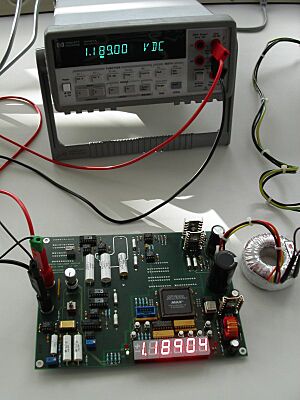Voltmeter facts for kids
A voltmeter is a cool tool that helps us measure voltage, which is like the "push" or "strength" of electricity. You can use it to check how much power is left in a battery! The idea for voltmeters started way back in 1819 when a scientist named Hans Oersted invented a very basic one.
Contents
How to Connect a Voltmeter
To use a voltmeter, you connect two wires from it to the place where you want to measure the voltage. One wire is for the positive side, and the other is for the negative side.
It's important to connect the voltmeter correctly:
- The positive wire from the voltmeter goes to the more positive part of the power source.
- The negative wire goes to the more negative part.
This way, the voltmeter connects parallel to the electrical circuit. This means it measures the voltage across two points without stopping the flow of electricity.
Safety First!
Always be very careful when connecting a voltmeter, especially if you are dealing with high voltages. Touching the metal parts directly when there's a lot of electricity can be dangerous and could hurt you. Always ask an adult for help if you are unsure.
How Voltmeters Show Voltage
Once connected, the voltmeter shows you the voltage. Voltmeters are actually a special kind of ammeter. They figure out the voltage by measuring the electrical current and using a rule called Ohm's law.
There are two main types of voltmeters:
Needle Voltmeters
One type has a needle, or "pointer," that moves to show a number on a scale. This number tells you how many volts there are. With these older types, you have to be careful to connect the positive and negative wires correctly. If you connect them the wrong way, the voltmeter could get damaged.
Digital Voltmeters
The second type shows the numbers on a screen, just like a digital clock or a calculator. These are called "digital" voltmeters. They are usually safer because they won't get damaged if you connect them the wrong way. Instead, they will just show a negative number, like "-5 volts," which tells you the connection is reversed.
AC and DC Voltmeters
Voltmeters are also designed for different kinds of electricity:
- Some work with direct current (DC), like the power from a battery.
- Others work with alternating current (AC), which is the power that comes from wall outlets in your home.
Many modern voltmeters can measure both DC and AC electricity.
Choosing the Right Voltmeter Setting
Every voltmeter has a "maximum number" of volts it can safely measure. If you try to measure a voltage that is too high for the voltmeter, it could get damaged or even break.
Voltmeters with Settings
Because of this, most voltmeters have a "knob" or a switch. This switch lets you choose different settings for different voltage ranges. For example, one setting might measure up to 10 volts, while another might measure up to 100 volts. Inside the voltmeter, this switch changes tiny parts called resistors in a voltage divider to adjust how it measures.
This way, one voltmeter can be used for many different voltages, both big and small. Some very modern voltmeters can even pick the right setting all by themselves! You just connect them, and they automatically find the best setting to measure the voltage.
Multimeters: Many Tools in One
Today, a voltmeter is often part of a bigger tool called a multimeter. A multimeter can do many jobs, like being a voltmeter, an ammeter (which measures current), and sometimes other measuring tools too. Multimeters also have switches to tell them what you want to measure.
Multimeters often have more than two places to connect wires. The instruction manual for the multimeter will show you which connection points to use for each type of measurement.
Measuring Very Small Voltages
Older voltmeters with needles need a little bit of energy from the thing they are measuring to move the needle. If the voltage source is very weak, it might not have enough energy to move the needle correctly. In this case, the voltmeter might show a voltage that is too low, or it might not be "sensitive" enough.
To solve this, scientists invented electronic amplifiers using things like vacuum tubes and transistors. By adding an amplifier, a voltmeter can measure very tiny voltages from very weak sources. Most modern voltmeters and multimeters have these amplifiers built in, making them much more accurate for small measurements.
Images for kids
See also
 In Spanish: Voltímetro para niños
In Spanish: Voltímetro para niños



